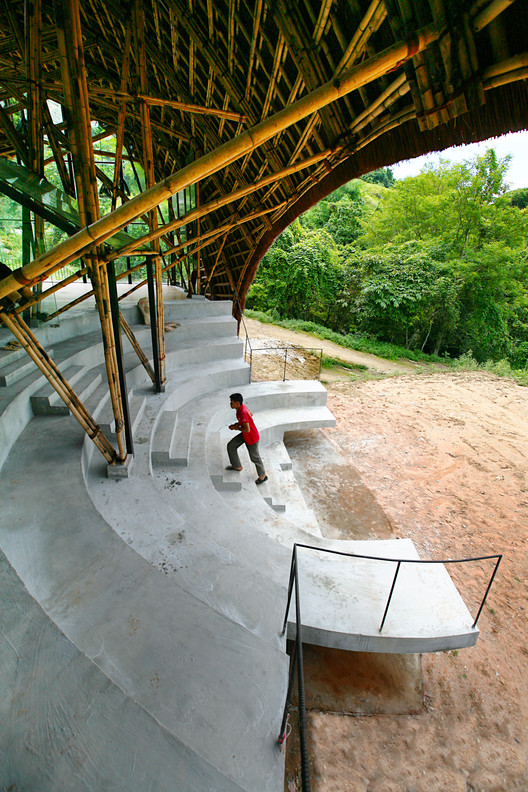Roy Lichtenstein Temporary Museum Diogo Aguiar Studio + João Jesus Arquitectos
2018-10-06 09:00
© Fernando Guerra | FG+SG
费尔南多·格拉


架构师提供的文本描述。作为一项旨在使艺术更贴近人们的倡议的一部分,Diogo Aguiar Studio和若昂·耶稣·阿奎科托斯已经在里斯本的一个商业空间内建立了一个临时博物馆,接受美国艺术家罗伊·利希滕斯坦(1923-1997年)的作品。
Text description provided by the architects. As part of an initiative that seeks to bring art closer to people, Diogo Aguiar Studio and João Jesus Arquitectos have come up with a Temporary Museum to receive works by American artist Roy Lichtenstein (1923-1997) within a commercial space in Lisbon.
Text description provided by the architects. As part of an initiative that seeks to bring art closer to people, Diogo Aguiar Studio and João Jesus Arquitectos have come up with a Temporary Museum to receive works by American artist Roy Lichtenstein (1923-1997) within a commercial space in Lisbon.
© Fernando Guerra | FG+SG
费尔南多·格拉




© Fernando Guerra | FG+SG
费尔南多·格拉


利用这次机会,创造一个不那么传统的展览空间,远离白色和抽象立方体的逻辑,建筑师们试图探索容器和内容之间的更大关系,相信它有助于公众更多地参与和更好地理解公开的作品。
Taking advantage of the opportunity to create a less conventional exhibition space, away from the logic of the white and abstract cube, the architects sought to explore a greater relationship between container and content, believing that it could contribute to greater public involvement and a better understanding of the exposed works.
Taking advantage of the opportunity to create a less conventional exhibition space, away from the logic of the white and abstract cube, the architects sought to explore a greater relationship between container and content, believing that it could contribute to greater public involvement and a better understanding of the exposed works.
© Fernando Guerra | FG+SG
费尔南多·格拉


三个平面定义的展览空间,可以从三个点,在一个流动的连续性。这些艺术品被暴露在波纹和穿孔的黑色金属板材的弯曲墙壁中,这些墙假定像更长的距离一样透明,但这可以定义空间,并在较短的距离内显示出一些不透明度。
Three planes define the exhibition space, which is accessible from three points, in a fluid continuity. The artworks are exposed in curved walls of corrugated and perforated black metal sheet, which assume as transparent as a longer distance, but that can define space and reveal some opacity at a shorter proximity.
Three planes define the exhibition space, which is accessible from three points, in a fluid continuity. The artworks are exposed in curved walls of corrugated and perforated black metal sheet, which assume as transparent as a longer distance, but that can define space and reveal some opacity at a shorter proximity.
Axonometric


一方面,金属片上的穿孔是指艺术家的形象(甚至是他在雕塑中的一些创作),另一方面,通过强烈的色彩对比,黑色的色调使艺术作品有了更多的证据。以艺术家在他的作品中所使用的颜色为参考,油毡地板和铰接式灯具呈现出柠檬黄色的颜色,为临时展览空间提供了一种流行美学。
If, on the one hand, the perforation on the metal sheet refers to the artist's image (and even some of his creations within sculpture), on the other hand, it’s dark tonality places the artistic works in greater evidence, by the strong chromatic contrast. Taking as a reference the colors used by the artist in his artworks, the linoleum floor, and the articulated luminaires assume the lemon-yellow color, contributing to give a Pop aesthetic to the temporary exhibition space.
If, on the one hand, the perforation on the metal sheet refers to the artist's image (and even some of his creations within sculpture), on the other hand, it’s dark tonality places the artistic works in greater evidence, by the strong chromatic contrast. Taking as a reference the colors used by the artist in his artworks, the linoleum floor, and the articulated luminaires assume the lemon-yellow color, contributing to give a Pop aesthetic to the temporary exhibition space.
© Fernando Guerra | FG+SG
费尔南多·格拉


© Fernando Guerra | FG+SG
费尔南多·格拉




































Architects Diogo Aguiar Studio, João Jesus Arquitectos
Location Av. Lusíada, 1500-392 Lisbon, Portugal
Area 150.0 m2
Project Year 2018
Photographs Fernando Guerra | FG+SG
Category Temporal Installations
























